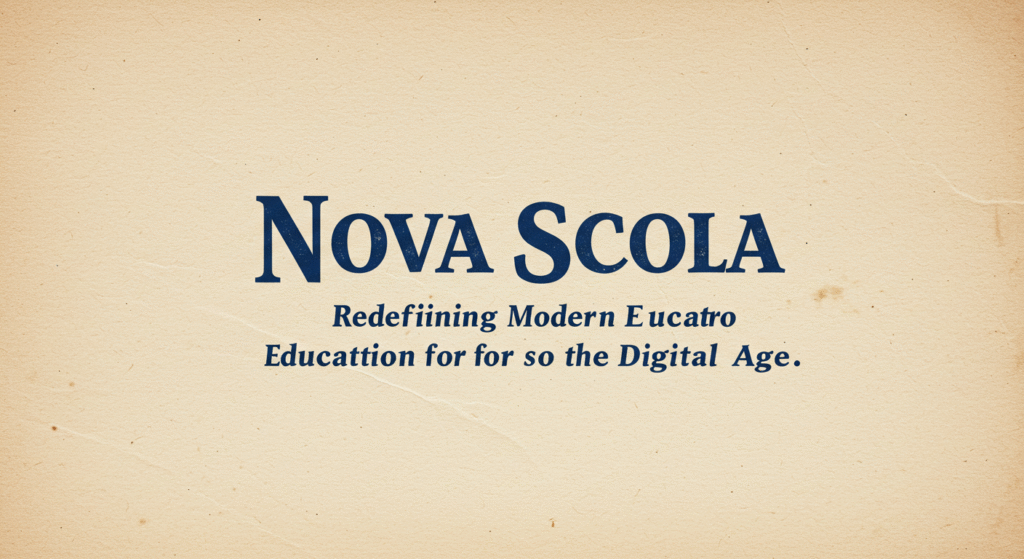In a world where technology and innovation drive every aspect of life, Nova Scola has emerged as a transformative force in education. The concept of Nova Scola represents a new model of schooling that blends technology, creativity, and real-world application to prepare students for the challenges of the 21st century. Unlike traditional schools that focus primarily on memorization and standardized testing, Nova Scola promotes experiential learning, emotional intelligence, and digital literacy. This approach is reshaping how educators, students, and communities view the purpose of education.
Understanding the Concept of Nova Scola
At its core, Nova Scola is not just a physical institution but a philosophy of learning. The term “Nova Scola,” derived from Latin roots meaning “new school,” emphasizes innovation and adaptability. The Nova Scola approach integrates technology with critical thinking and problem-solving skills to cultivate well-rounded learners.
Rather than sticking to rigid curriculums, Nova Scola encourages flexible learning pathways that allow students to explore subjects based on their interests, learning pace, and strengths. This student-centered model is redefining what it means to educate in the digital era.
How Nova Scola Differs from Traditional Education
One of the main distinctions between Nova Scola and traditional education systems lies in the method of delivery. Traditional systems often prioritize theoretical knowledge, while Nova Scola emphasizes applied learning.
-
Personalized Learning: Nova Scla utilizes AI-driven tools and digital platforms to personalize education. Students receive customized lessons that adapt to their progress and comprehension.
-
Collaborative Projects: Instead of rote assignments, students work on real-world projects that foster teamwork and innovation.
-
Holistic Development: Emotional intelligence, communication, and creativity are as important as academic success.
-
Digital Integration: Technology isn’t an add-on; it’s embedded in every aspect of the Nova Scla model, preparing students for tech-driven careers.
This shift not only improves engagement but also ensures that students are better prepared for future job markets and societal challenges.
The Core Principles of Nova Scola
Every Nova Sola institution or model is built upon key educational principles that guide its structure and operation:
-
Innovation and Creativity: Encouraging learners to think differently and experiment with new ideas.
-
Inclusivity: Providing equal opportunities regardless of socio-economic background, gender, or learning ability.
-
Sustainability: Teaching respect for the environment and the importance of sustainable practices.
-
Technology Integration: Using digital tools responsibly and effectively in everyday learning.
-
Lifelong Learning: Instilling curiosity and adaptability that go beyond formal education.
These principles make Nova Sola a framework for continuous growth rather than a one-size-fits-all educational model.
The Role of Technology in Nova Scola
Technology is the cornerstone of the Nova Scoa philosophy. It’s not merely a tool but a transformative force that redefines how learning occurs. Through smart classrooms, virtual reality simulations, and digital collaboration tools, students gain access to interactive and engaging learning experiences.
AI-powered assessment systems can identify learning gaps and recommend tailored resources. Gamified lessons make complex topics fun and memorable, while digital portfolios allow students to showcase their skills and creativity. With these advancements, Nova Scoa ensures that technology enhances learning rather than distracts from it.
Global Adoption and Impact of Nova Scola
The Nova Scola model is gaining traction across the globe, particularly in regions striving to modernize outdated education systems. Countries in Europe, Asia, and Latin America have begun adopting elements of the Nova Scoa philosophy to meet the growing demand for skill-based education.
For example, pilot programs using Nova Scla principles have introduced flexible curriculums that allow students to combine art with science or technology with social studies. These hybrid models are proving effective in increasing student engagement, reducing dropout rates, and improving overall academic performance.
Moreover, Nova Scoa has encouraged partnerships between schools and tech companies, ensuring that educational content remains up-to-date and relevant to modern industries.
Teacher Transformation in Nova Scola
Teachers in the Nova Scla system are not just instructors—they are mentors, facilitators, and lifelong learners. Their role shifts from delivering lectures to guiding students through discovery-based learning. Professional development programs under Nova Scoa emphasize digital literacy, emotional intelligence, and interdisciplinary teaching methods.
By empowering educators with modern tools and flexible teaching frameworks, Nova Sola ensures that teachers become co-learners who evolve alongside their students. This creates a more engaging and collaborative classroom environment.
Challenges Facing the Nova Scola Model
While Nova Sola presents a revolutionary vision for education, it also faces several challenges in implementation. These include:
-
Digital Divide: Not all students have access to the necessary technology or internet connectivity.
-
Teacher Training Gaps: Many educators require extensive retraining to adopt Nova Scla methodologies.
-
Assessment Methods: Standardized testing systems often fail to measure creative and critical thinking skills.
-
Cultural Resistance: Traditional education systems are deeply rooted in many societies, making reform difficult.
Despite these challenges, the Nova cola model continues to evolve, finding ways to make innovative education accessible and sustainable for all learners.
The Future of Nova Scola: A Vision Beyond Classrooms
The future of Nova Sola lies in expanding beyond physical classrooms into a global digital ecosystem. With the rise of online learning platforms, AI-driven tutors, and metaverse-based education, Nova Scla is poised to redefine lifelong learning.
Imagine students collaborating across continents in virtual labs, exploring digital museums, or learning history through immersive simulations. This vision aligns with Nova Scola’s mission—to make education borderless, engaging, and transformative.
As society moves deeper into the digital age, Nova Scola’s flexible and innovative model may become the global standard for education, bridging the gap between traditional schooling and modern needs.
Conclusion: Nova Scola as the Future of Learning
In essence, Nova Scola is more than just a trend—it’s a reimagining of what education should be in the modern world. By focusing on creativity, inclusivity, and technology, Nova Sola equips learners with the skills and mindset needed to thrive in an unpredictable future.
As schools, governments, and educators continue to embrace this model, the Noa Scola philosophy stands as a beacon for educational transformation—one that empowers individuals not just to learn, but to innovate, adapt, and lead with purpose.






